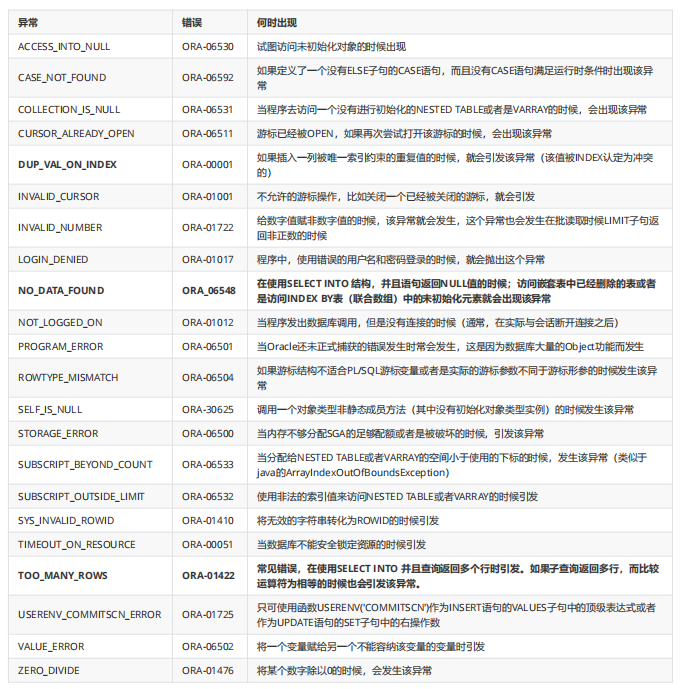在java的编程中,我们经常会抛出各种各样的异常,程序从上而下执行,当出现异常,而我们没有处理时,就会报错,程序就会终止运行,因此我们在java中使用throw和try/catch来处理异常信息,pl/sql中将sql语句作为了一个程序块,当出现了异常时,就会导致整个程序块不能运行,因此我们也需要对其进行异常处理。
在pl/sql中有三个类型的异常错误:
1.预定义错误
2.非预定义错误
3.用户定义错误
异常处理部分通常放在程序块的后半部分,结构为:
declare begin -- 程序块 exception when first_exception(异常名) then 异常处理语句; when second_exception(异常名) then 异常处理语句; when others then 异常处理语句; end;
预定义错误:由oracle预定义的异常错误有24个,对这种异常情况的处理,无需在程序中定义,由oracle自动将其引发

对于以上异常情况的处理,直接引用异常名并进行处理即可。
举例:
declare v_row emp%rowtype; begin select * into v_row from emp where job='CLERK'; exception when no_data_found then dbms_output.put_line('表中没有该数据'); when TOO_MANY_ROWS then dbms_output.put_line('有多条数据'); when others then dbms_output.put_line('111'); end;
2.非预定义异常的处理
对于这类异常情况的处理,必须首先对其定义,步骤如下:
1.在pl/sal块的定义部分定义异常情况:
异常情况 EXCEPTION;
2.将定义好的异常情况与oracle错误联系起来,使用exception_init语句:
PRAGMA EXCEPTION_INIT(<异常情况>, <错误代码>);
3.在pl/sql的异常处理部分对异常情况做出相应的处理。
举例说明:
declare dept_not_found exception ; pragma exception_init (dept_not_found ,-2291); begin update emp set deptno=90 where empno=7788; exception when dept_not_found then dbms_output.put_line('该部门不存在'); end;
3.用户自定义错误
用户可以自定义异常处理,举例:
declare empno_not_found exception ; begin delete from emp where empno=987987; if sql%notfound then raise empno_not_found; end if; exception when empno_not_found then dbms_output.put_line('找不到该员工'); end;